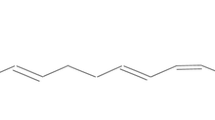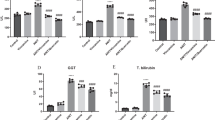Abstract
The effects of schisandrin B (Sch B), a dibenzocyclooctadiene derivative isolated from the fruit of Schisandra chinensis, and dimethyl diphenyl bicarboxylate (DDB), a synthetic intermediate of schisandrin C (also a dibenzocyclooctadiene derivative), on hepatic mitochondrial glutathione redox status in control and carbon tetrachloride (CCl4)-intoxicated mice were examined. Treating mice with Sch B or DDB at a daily oral dose of 1 mmol/kg for 3 d did not produce any significant alterations in plasma alanine aminotransferase (ALT) and sorbital dehydrogenase (SDH) activities. CCl4 treatment caused drastic increases in both plasma ALT and SDH activities in mice. Pretreating mice with Sch B or DDB at the same dosage regimen significantly suppressed the CCl4-induced increase in plasma ALT activity, with the inhibitory effect of Sch B being much more potent. Sch B, but not DDB, pretreatment could also decrease the plasma SDH activity in CCl4-intoxicated mice. The lowering of plasma SDH activity, indicative of hepatoprotection against CCl4 toxicity, by Sch B pretreatment was associated with an enhancement in hepatic mitochondrial glutathione redox status as well as an increase in mitochondrial glutathione reductase (mtGRD) activity in both non-CCl4 and CCl4-treated mice. DDB pretreatment, though enhancing both hepatic mitochondrial glutathione redox status and mtGRD activity in control animals, did not produce any beneficial effect in CCl4-treated mice. The difference in hepatoprotective action against CCl4 toxicity between Sch B and DDB may therefore be related to their ability to maintain hepatic mitochondrial glutathione redox status under oxidative stress condition.
Similar content being viewed by others
References
Li XY: Bioactivity of neolignans from fructus Schizandrae. Memorias do Instituto Oswaldo Cruz. 86: 31–37, 1991
Liu KT, Lesca P: Pharmacological properties of Dibenzo[a,c]cyclooctene derivatives isolated from Fructus Schizandrae Chinensis III. Inhibitory effects on carbon tetrachloride-induced lipid peroxidation, metabolism and covalent binding of carbon tetrachloride to lipids. Chem-Biol Interact 41: 39–47, 1982
Yoshida T, Ueno T, Miyazaki A, Sugie H, Yoshida M: Clinical effect of biphenyl dimethyl dicarboxylate administration on chronic hepatitis. Jpn J Gastroenterol 86: 965, 1989
Liu GT: Schisandra Chinensis and Dimethyl diphenyl bicarboxylate. In: Z.Y. Sung (ed). Modern Research in Chinese Herbal Medicine Vol.1. Beijing University and Hip Wo Press, Beijing, 1995, pp 403–404
Li XJ, Zhao BL, Liu GT, Xin WJ: Scavenging effects on active oxygen radicals by schizandrins with different structures and configurations. Free Rad Biol Med 9: 99–104, 1990
Lu H, Liu GT: Anti-oxidant activity of dibenzocyclooctene lignans isolated from Schisandraceae. Planta Med 58: 311–313, 1992
Zhang TM, Wang BE, Liu GT: Effect of schisandrin B on lipoperoxidative damage to plasma membrane of rat liver in vitro. Acta Pharmacol Sin 13: 255–258; 1992
Ip SP, Poon MKT, Che CT, Ng KH, Kong YC, Ko KM: Schisandrin B protects against carbon tetrachloride toxicity by enhancing the mitochondrial glutathione redox status in mouse liver. Free Rad Biol Med 21: 709–712, 1996
Ip SP, Ko KM: The crucial antioxidant action of schisandrin B in protecting against carbon tetrachloride hepatotoxicity in mice: A comparative study with butylated hydroxytoluene. Biochem Pharmacol 52: 1687–1693, 1996
Ip SP, Poon MKT, Wu SS, Che CT, Ng KH, Kong YC, Ko KM: Effect of schisandrin B on hepatic glutathione antioxidant system in mice: Protection against carbon tetrachloride toxicity. Planta Med 61: 398–401, 1995
Laganiere S, Yu BP: Anti-lipoperoxidation action of food restriction. Biochem Biophys Res Comm 145: 1185–1191, 1987
Reed DJ, Babson JR, Beatty PW, Brodie AE, Ellis WW, Potter DW: High-performance liquid chromatography analysis of nanomole levels of glutathione, glutathione disulfide, and related thiols and disulfides. Anal Biochem 106: 55–62, 1980
Godin DV, Garnett ME: Species-related variations in tissue antioxidant status I. Differences in antioxidant enzyme profiles. Comp Biochem and Physiol B: 103: 737–742, 1992
Liu J, Liu Y, Klaassen CD: The effect of Chinese hepatoprotective medicines on experimental liver injury in mice. J Ethnopharmacol 42: 183–191, 1994
Tomasi A, Albano E, Banni S, Botti B, Corongiu F, Dessi MA, Iammone A, Vannini V, Dianzani MU: Free-radical metabolism of carbon tetraachloride in rat liver mitochondria. Biochem J 246: 313–317, 1987
Shan X, Jones DP, Hashmi M, Anders, MW: Selective depletion of mitochondrial glutathione concentrations by (R,S)-3-hydroxy-4-pentenoate potentiates oxidative cell death. Chem Res Toxicol 6: 75–81, 1993
Garcia-Ruiz C, Colell A, Mari M, Morales A, Fernandez-Checa JC: Direct effect of ceramide on the mitochondrial electron transport chain leads to generation of reactive oxygen species. Role of mitochondrial glutathione. J Biol Chem 272: 11369–11377, 1997
Ip SP, Ma CY, Che CT, Ko KM: Methylenedioxy group as determinant of schisandrin in enhancing hepatic mitochondrial glutathione in carbon tetrachloride-intoxicated mice. Biochem Pharmacol 54: 317–319, 1997
Author information
Authors and Affiliations
Rights and permissions
About this article
Cite this article
Ip, SP., Yiu, HY. & Ko, KM. Differential effect of schisandrin B and dimethyl diphenyl bicarboxylate (DDB) on hepatic mitochondrial glutathione redox status in carbon tetrachloride intoxicated mice. Mol Cell Biochem 205, 111–114 (2000). https://doi.org/10.1023/A:1007065917665
Issue Date:
DOI: https://doi.org/10.1023/A:1007065917665




